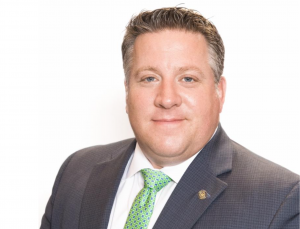
Leading the Local Response for Those Most in Need
An Excerpt from Chapter 2 of Our Darkest Hours: New York County Leadership and the COVID Pandemic
One crucial aspect of our COVID-19 response was communicating with the public as well as my counterparts across the state and country. My daily press conferences were a great way to reassure people and to provide updates on how their lives would be changing. As the virus spread, I was joined by Albany County Department of Health Commissioner Dr. Elizabeth Whalen to provide guidance to the community. I used the press conferences to announce my concerns and to bring in the sheriff, district attorney, mayor, faith, business and school leaders to offer their expertise and insight. My office also functioned as a source of information for the public. My staff fielded calls, emails, and messages on social media related to the shutdown, local response activities, unemployment, reopening, general information, complaints, and more. Our administrative staff answered the questions they could and forwarded other questions to the appropriate staff for follow-up. And as president of both the County Executives of America as well as the NYS County Executives’ Association, I have been able to share what we have learned with my colleagues and in turn, heard about their successes and challenges.
We were learning on the fly, and I’m especially proud of our food distribution program. By partnering with the Regional Food Bank of Northeastern New York and the National Guard, we were able to deliver fifty-six hundred boxes of food (each box contained around thirty-five pounds of groceries) to quarantined families in just over two months. The program enabled people to comply with quarantine orders and helped to depress the infection rate.
We were also able to launch mobile testing sites. I’d seen the reports showing that COVID-19 was disproportionately impacting Black and Brown communities, and the ability to partner with a trusted healthcare provider like Whitney M. Young, Jr. Health Center and bring testing directly to underserved communities was a source of pride for the county, and Albany County was one of the first in the state to do so. Locating the testing sites within minority and lower socioeconomic communities was crucial to monitoring infection rates and community spread among a vulnerable population.
It became clear early on that any extended economic shutdown and quarantine would have serious implications on the mental well-being of residents. That’s why within the first week of us identifying our first positive cases, we established a mental health support line to help those struggling with anxiety, depression, or simply struggling to make sense of everything. We had experts on the phone reassuring people that they were never alone during this crisis. This had far-reaching benefits, and I count it as one of the most important actions we took during the worst of the pandemic.
***
Any response to a pandemic requires a partnership between state and local governments, and overall, we worked well with the State of New York. That isn’t to say there weren’t some speed bumps. County government workforces were already stretched thin dealing with the public health implications of the crises, but the governor’s executive orders required us to shoulder an even greater workload. Here’s one example: the state established the PAUSE Enforcement Assistance Task Force, where individuals could complain about the operation of nonessential businesses or gatherings. Yet the county had to assess the validity of the complaints and forward them to the appropriate law enforcement jurisdiction for follow-up.
At times, communication from the state wasn’t as helpful as we’d hoped. When it came to shutdowns and reopening plans, the state left county governments scrambling to respond once updates were announced at the governor’s briefings. The state has somewhat rectified the initial lack of communication by establishing regional control rooms. The rooms are an effective way to interact with officials, but they don’t give control to local decision-makers. Furthermore, the governor’s orders raised legal and jurisdictional questions which further complicated enforcement measures. This increased burden has taken a toll on our coffers. Yet the governor has been unwilling to share any of the money received from the Coronavirus Relief Fund, and this has left us grasping for a lifeline.
Finally, there have been discrepancies in the reporting of COVID-19 hospitalizations, cases, and deaths between the county and New York State. While the state was using Hospital Emergency Response Data System to count hospitalizations and deaths, we were using a more in-depth forensic accounting of deaths by verifying the residence of those who passed away. I argued that the state’s data wasn’t truly reflective of community level spread, because people were being sent to our hospitals from outside the county and the Capital Region.
Dan McCoy currently serves as Albany County Executive.
The New York State County Executives’ Association, in collaboration with NYSAC, presents stories of county leadership during the COVID-19 pandemic, told by the County Executives who were on the ground leading the local response.
Our Darkest Hours: New York County Leadership & the COVID Pandemic, uses riveting first-person accounts to provide a glimpse into the fear, struggle, triumph, and pain that local leaders faced as they worked to protect their residents from an invisible and insidious enemy.
The book also provides a public policy account of the fractured federal and state response to COVID-19 and explores the economic impact of New York on Pause, the unprecedented expansion of state executive powers, and the diminution of local home rule. The Appendices include material relating to congressional actions, the state’s executive orders, and COVID cases/deaths by county from March 15, 2020 to March 15, 2021.
Our Darkest Hours: New York County Leadership and the COVID Pandemic is available for purchase from Archway Publishing and Amazon for $19.99 (softcover) and $37.95 (hardcover) and $4.99 (Kindle). All proceeds from the book will be donated to Feeding New York State, which supports the ten regional food banks that have been feeding the hardest hit New Yorkers.

